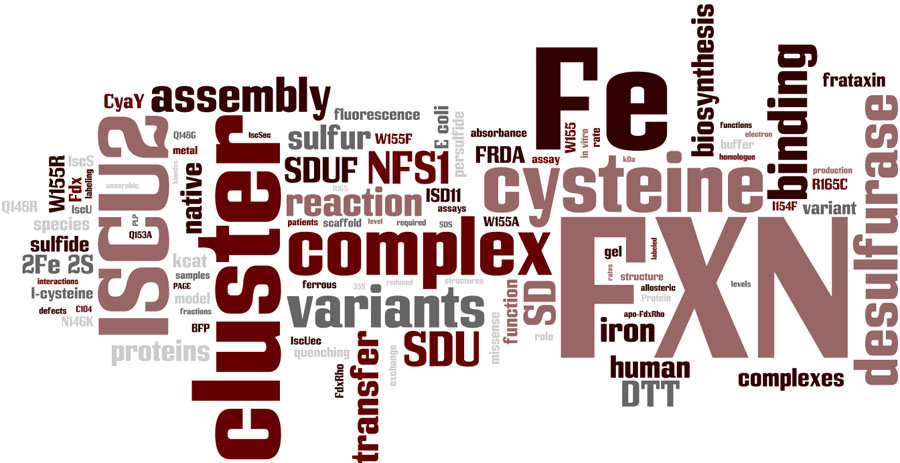Investigating the structure and mechanism of the human Fe-S cluster assembly complex

There is increasing evidence for mitochondrial involvement in neurodegenerative diseases including Alzheimer’s and Parkinson’s diseases, Lou Gehrig’s disease, multiple sclerosis, and Friedreich’s ataxia (FRDA). Mutations, either inherited or acquired, lead to an impaired electron transport chain that, in turn, results in decreased ATP production, increased formation of toxic free radicals, and altered calcium homeostasis. The free radicals can cause further damage to mitochondrial DNA, proteins, and lipids and eventually lead to cell degeneration and death. Fe-S clusters are essential cofactors required for the electron transport chain as well as many other biochemical reactions and processes. Critical cofactor assembly systems are required to sequester, chaperone, and regulate metal ions. Defects in these systems lead to metal ion metabolic disease and result in cellular, tissue, and systemic pathology. The Fe-S cluster assembly pathway contains a conserved set of metallochaperone proteins that recognize and insert Fe-S clusters into apo metalloproteins. This is a difficult task as a wide variety of protein architectures house Fe-S clusters in environments that range from solvent exposed to completely buried. This assembly system is not required to “build” Fe-S clusters (the clusters will self assemble in solution), but is thought to be necessary to circumvent the toxicity and indiscriminant reactivity of “free” iron and sulfide. Defects in the biogenesis of iron-sulfur clusters are directly associated with mitochondrial dysfunction, cardiovascular and neurodegenerative disease, and contribute to genomic instability, the development of cancer, and aging.
In eukaryotes, the Fe-S cluster biosynthesis pathway operates in the matrix space of the mitochondria and includes at least a dozen proteins. Human Isu2 provides a scaffold for building [Fe2S2], and possibly, [Fe4S4] clusters. Clusters are synthesized on Isu2 through interactions with proteins that mediate sulfur, iron, and electron transfer. Nfs1 and Isd11 provide the sulfur through a PLP-dependent cysteine desulfurase reaction. Most researchers agree that frataxin (Fxn) functions in Fe-S cluster biosynthesis, possibly as an iron chaperone. Fxn has been intensively studied since the discovery that the neurodegenerative disease Friedreich’s ataxia is caused by loss-of-function mutations in the FXN gene, primarily by an expanded GAA triplet repeat in the first intron. Some FRDA patients also have specific mutations in the coding region of Fxn that presumably alter its function. After cluster synthesis, a set of co-chaperone proteins assists in delivering the intact cluster from the scaffold protein to an apo target protein.
We recently characterized a stable four-protein (Nfs1, Isd11, Isu2, and Fxn) SDUF complex that functions as the catalyst for the biosynthesis of Fe-S clusters in humans (Fig. 1). Moreover, we discovered that Fxn (together with Fe) functions as an allosteric activator that switches the assembly complex on for Fe-S cluster biosynthesis. The identification of the core Fe-S assembly complex machinery and the role of Fxn as an allosteric activator are paradigm-shifting discoveries that provide new research opportunities and directions. The allosteric activator role suggests that Fxn protein levels may be controlled by environmental cues as a mechanism to regulate Fe-S cluster biosynthesis and leads to obvious cell biology and genetic experiments that other researchers are already pursuing. In this proposal, we aim to build on these results by further developing our in vitro system and providing structural properties for the assembly complexes, mechanistic details for Fe-S cluster synthesis, and determine the basis for the compromised function in FRDA clinical variants. This fundamental research will establish a framework for emerging genetic results and discoveries and provide a basis for understanding defects in iron-sulfur cluster metabolism relevant to human health and disease. We have 3 aims.
Moreover, we discovered that Fxn (together with Fe) functions as an allosteric activator that switches the assembly complex on for Fe-S cluster biosynthesis. The identification of the core Fe-S assembly complex machinery and the role of Fxn as an allosteric activator are paradigm-shifting discoveries that provide new research opportunities and directions. The allosteric activator role suggests that Fxn protein levels may be controlled by environmental cues as a mechanism to regulate Fe-S cluster biosynthesis and leads to obvious cell biology and genetic experiments that other researchers are already pursuing. In this proposal, we aim to build on these results by further developing our in vitro system and providing structural properties for the assembly complexes, mechanistic details for Fe-S cluster synthesis, and determine the basis for the compromised function in FRDA clinical variants. This fundamental research will establish a framework for emerging genetic results and discoveries and provide a basis for understanding defects in iron-sulfur cluster metabolism relevant to human health and disease. We have 3 aims.
Aim 1. Elucidate the structural basis for assembly complexes and conformational changes critical for human Fe-S cluster biosynthesis.
Aim 2. Probe the chemical mechanisms for human Fe-S cluster assembly and transfer.
Aim 3. Determine ability of FRDA clinical and modified frataxin variants to function as allosteric activators for Fe-S cluster biosynthesis.
